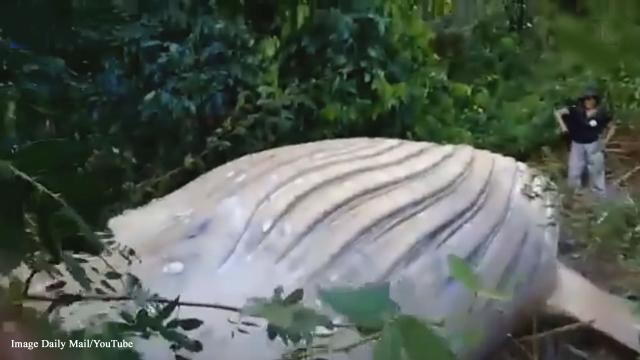After vultures were seen circling over a spot in the Amazon rainforest, wildlife experts discovered the body of a dead humpback whale. Weighing in at 10 tons and measuring 11 metres in length, the young whale was found on Marajo Island, deep in the jungle undergrowth. The island is located at the mouth of the Amazon River.
As reported by the Telegraph, while experts were at first baffled, scientists assume the enormous mammal had been hurled into the rainforest during a storm. However, they cannot say how the whale landed so far inland, or for that matter, why it had been swimming off the coast at all.
Vultures point the way to dead whale
According to officials from the state’s health, sanitation, and environmental department, they had found the whale carcass after they followed the vultures which were feasting on the massive carcass. It wasn’t easy for them to get to the whale’s body either, as it was located in an extremely remote section of the mangrove swamp on the Amazonian delta. Apparently, it took two trips for the experts to finally reach the site.
Marine specialists examine the carcass
According to the Independent, Bicho D’agua Institute is a conservation group on Marajo, and their marine specialists form part of the team currently examining the whale’s carcass. They believe the whale died a number of days before it was discovered.
Their project leader, Renata Emin, said they are not sure how the carcass got there, but they assume the whale was floating close to shore when the tide, which has been strong for a few days, must have picked it up and thrown it into the inland mangrove. Saying this was an “astonishing” feat, considering the size of the whale, she said they are also baffled as to why a humpback whale was off the north coast of Brazil in February, as this is an unusual occurrence.
Reportedly the whales are more commonly seen on the Bahia coast of Brazil, further to the south, between August and November. However, they rarely make the journey of thousands of kilometres to the Amazon mouth.
Emin believes the whale is a calf, separated from its mother during migration back south.
According to scientists, there are no clear reasons as to the animal’s death, but they are taking samples from its carcass to perform further studies. However, she added that with the state of the carcass’s decomposition, some vital information might have already been lost. They are currently identifying wounds and marks on the body to establish whether it was hit by a boat or caught in a net.
According to Dirlene Silva of the state environment department, the carcass will be left where it landed in the Amazon jungle. Besides the size of the creature, she said it is very difficult to access the site and no way to remove it, as they have to cross a swamp to get there. They will, however, eventually dismantle and preserve the whale skeleton to send it to a natural history museum in Belem for further study.
![A humpback whale was discovered in the heart of the Amazon rainforest, baffling scientists. [Image Daily Mail/YouTube] A humpback whale was discovered in the heart of the Amazon rainforest, baffling scientists. [Image Daily Mail/YouTube]](https://staticr1.blastingcdn.com/media/photogallery/2019/2/26/660x290/b_502x220x82/a-humpback-whale-was-discovered-in-the-heart-of-the-amazon-rainforest-baffling-scientists-image-daily-mailyoutube_2214611.jpg)


